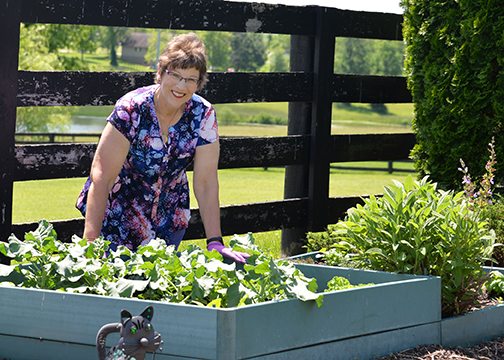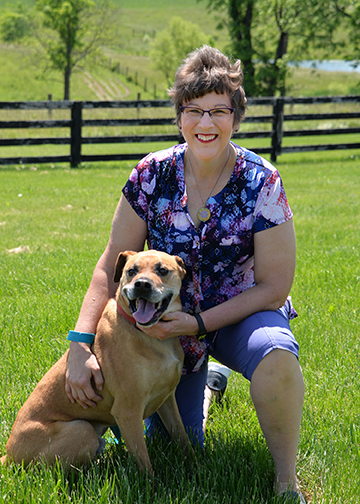
Amy's story
severe spinal deformity
It was the hardest decision she had ever made. Wracked by pain, unable to stand up straight, exhausted from fighting a losing battle, Dr. Amy Mashburn decided to sell her solo medical practice and take an indefinite leave of absence. It was a heart-breaking move for a physician who had served central Kentucky as a pediatric allergist and immunologist for 16 years.
"I had to give up my whole career," says Dr. Mashburn, who has doctorate as well as a medical degree from Vanderbilt University. "I couldn't take medications when I was seeing patients, and I couldn't continue functioning because of the amount of pain I was in. It was a huge deal for me to give in and say I couldn't do this anymore."
By this time Dr. Mashburn, a single mother, had endured 11 surgeries on her neck and back, and about 20 smaller pain-management procedures, including epidural steroid injections and nerve blocks. A surgically implanted pain pump delivered medication to the area near her spinal cord. But nothing had worked. Her spine had betrayed her, one vertebra at a time. "I didn't know anyone could fix my back," she says.
Spinal reconstruction surgery: Amy's story
And then, an unexpected turn. Her pain specialist at the University of Kentucky advised her to go see Robert Bohinski, MD, PhD, a neurosurgeon at Mayfield Brain & Spine known for undertaking marathon spinal reconstructions over a period of two days.
Her first visit with Dr. Bohinski would mark the beginning of a months-long path not only to rehabilitation, but also to a kind of rebirth. Today, standing tall, she drives, swims, gardens, and is planning her return to medicine. "Thank God I found Dr. Bohinski and he has the skill he has," Dr. Mashburn says. "Thank you doesn't seem adequate for what he has done in my life."
Functional impairment, on so many levels

When Dr. Bohinski first saw Dr. Mashburn in November 2015, he saw a cascade of trouble. The overall name for her condition was "iatrogenic deformity" or "flat back syndrome," the result of complications from previous surgeries. She also suffered from junctional kyphosis, a complication of spinal fusion surgery that resulted in a rounded upper back.
"Different people had been trying to help her," Dr. Bohinski says. "Sometimes an individual's entire spine problem doesn't make itself known all at once. You're managing parts of the global problem at different points in time. And her disease just kept progressing, one level after the next."
Dr. Mashburn first began having back pain when she was in college. After giving birth to her son, her pain worsened and she was diagnosed with spinal instability. She had her first major back operation in 2001 for instability in her middle back. "After that, my back fell apart," she says. She developed a staph bone infection in her spine and underwent four surgeries in 2004 and 2005 because of the infection. In 2006 she ruptured a disc just below the surgical site. She subsequently developed spondylolisthesis, the forward displacement of one vertebra over another.
"Every year after 2005 I got more bent over," she says. "The last few years were horrible. By the time I saw Dr. Bohinski, I was so bent over that I knew people's shoes better than I knew their face."
Cervical spine repair comes first
But before Dr. Bohinski could address Dr. Mashburn's back, he had to address her neck. He could see immediately that Dr. Mashburn was exhibiting spinal cord symptoms: numbness and tingling in her arms, spasticity when she walked, and clumsiness in her hands. X-rays revealed that two of the three fusions in her cervical spine had not healed. Hardware was coming out of the vertebrae, and the space between her spine and spinal cord was dangerously narrow.
"The neck had to be done first to make it safe to do the real difficult part, which was the thoracolumbar deformity, which extended from her chest to her sacrum," Dr. Bohinski says.

Operating at The Christ Hospital over a period of 3 ½ hours, he removed the old hardware, relieved the pressure on her spinal cord, and fused her neck from C-3 to C-7. He then prescribed four months of recovery before addressing her spine.
When Dr. Mashburn returned to The Christ Hospital, she was well aware of the risks posed by complex spinal deformity surgery.
"Dr. Bohinski was very honest and didn't downplay how risky the surgery was," she says. "He said there was a 75 to 80 percent likelihood of a major complication. The most worrisome to me was that my staph infection could return. I also could lose too much blood or throw a clot to my lungs. On the other hand, he was very confident he could improve my life. He was the first doctor who said, 'I can fix this. You may not like the process. There will be 6 to 12 months of recovery. But in the end you will be so glad that you did it.'"
For Dr. Mashburn, the choice was clear. "I was 52," she says. "I had an 18-year-old son about to go off to college. It was too early to say this is how I want the rest of my life to be. I didn't like the quality of life I had."
A surgical procedure in 2 stages
Dr. Bohinski operated on Dr. Mashburn for 3 hours the first day, fusing the lowest level of her spine. Working with a vascular surgeon, Sashi Kilaru, MD, Dr. Bohinski approached the spine through the abdomen, dissecting skillfully between muscles rather than cutting through them. The approach ensured a faster recovery.

The next day, he performed a 15½-hour surgery. He removed the old hardware and the pain pump. Then he created a surgical fracture through one vertebra – a pedicle subtraction osteotomy – so that he could realign and restore balance to the entire spine. He then inserted long rods from the upper back (T-4) to the pelvis. Like almost all patients who undergo spinal deformity surgery, Dr. Mashburn required transfusions (3 units of blood) during her surgery and recovery.
Dr. Mashburn spent 2 days in the surgical intensive care unit after the long surgery and a total of 7 in the hospital altogether. She then went home to recuperate. She was required to wear a brace for 3 months, but within two weeks, she no longer needed a walker.
A return to a life of motion
Over the next several months, Dr. Mashburn's life returned to a normalcy she had not known in years. Her son was shocked to discover that his mother was actually taller than he was. People screamed or began crying when they saw her. She was less irritable and no longer needed pain medications.
She started walking 2½ miles a day within weeks of her surgery, a feat she had not been able to do in more than 10 years. She completed 6 weeks of physical therapy, then began swimming and going to the gym. She returned to her garden. Nine months after the surgery, Dr. Bohinski gave her the go-ahead to return to work.
Her spine is not as good as new. Her back moves as a single unit, without the flexibility that a normal, healthy spine would have. And she retains some neuropathy in her legs, the result of the pressure her cervical vertebrae were placing on her spinal cord prior to her surgery with Dr. Bohinski.
But these are facts of life, not regrets. Her only real regret is not having found Dr. Bohinski sooner. "If I had known he was out there, I wouldn't have sold my practice," she says.
Even so, her story has a happy ending. In August 2017 Dr. Mashburn accepted the position of Camp Physician at the Center for Courageous Kids in Scottsville, Kentucky. "I am very happy to be back at camp with medically fragile children," she says. "It's a beautiful camp with a great mission that I totally believe in. We have facilities specially designed for handicapped campers of all ages, and all of our services are free to campers and their families."
~ Cindy Starr
Hope Story Disclaimer -"Amy's Story" is about one patient's health-care experience. Please bear in mind that because every patient is unique, individual patients may respond to treatment in different ways. Results are influenced by many factors and may vary from patient to patient.

Learn more about the anatomy of the spine.
"I'm so in awe of this man. How in the world do you do surgery for 15½ hours? It hurts to think about. Thank goodness there are people like him." – Amy Mashburn, MD, PhD


photos by Cindy Starr

